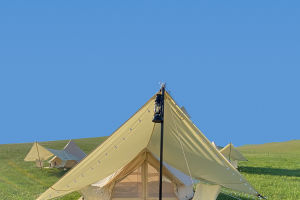Looking from a distance, I saw the brown camel with a hint of gold, and the two huge humps were the most conspicuous. These two humps are like two golden peaks, and the camel is stronger because of these two humps.
Its morphological characteristics.
The head is small, the neck is thick and long, curved like a gooseneck. Tall body with brown body hair.
The eyes are double eyelids, the nostrils can be opened and closed, the limbs are slender, the hooves are as large as discs, and the skin of the toes and soles of the feet is thick, all suitable for walking on sandy ground.
The tail is slender and has a tuft of hair at the end. There are 1 or 2 large humps on the back, which are used to store fat.
The camel's fur is very thick, and the winter in desert areas is very cold, and the camel's fur is extremely beneficial for maintaining body temperature.
Camels have thick hair that reflects sunlight. Their long legs also keep them away from hot ground.
Its habits.
Living environment.
Camels mainly live in grasslands, deserts and Gobi areas.
Character traits.
Camels are docile, alert and tenacious, quick in response, fast in running and perseverance.
Food.
Camels mainly eat grass.
Love salt.
Since the precipitation in arid regions of the desert is much lower than the evaporation of water vapor and the transpiration of plants, the salinity of plants in this area is higher. Camels live in arid desert regions and over time have developed a preference for plants with high salt content.
At the same time, drinking water is also saline-alkali lake water.
Thirsty.
The camel's ability to resist thirst is also very strong, and it can lead a normal life without drinking water for a long time. It's just that the body gradually loses weight, but after drinking water, it can fully recover within a few hours.
Resist hunger.
Camels can survive for 3 weeks without water and up to a month without food.
The plant and pasture resources in desert areas are extremely scarce, but camels still survive tenaciously. It adapts to the environment with a strong hunger tolerance. It can still move even without grass and feed for days and nights.
Camels have a large amount of food in summer and autumn, and are rich in aquatic plants. The daily food intake can reach 32.1-33.6 kg, which is converted into fat and stored in the hump and abdominal cavity.
When there is no grass in winter and spring, the fat stored in the hump and abdominal cavity is turned into energy to support the body's activities.
In addition, the camel's stomach has three chambers, which makes the camel more resistant to starvation.
Camels can run, but they run very slowly. In fact, camels usually walk very slowly, mainly because of their heavy body weight, especially the two humps on their bodies.
Camels have many tubes in their nostrils, which are usually kept moist. This way, if the body is dehydrated, the skin inside the ducts stops secreting.
Camels use their own breath to dissipate heat from their bodies, while also sending some water back into their bodies.


